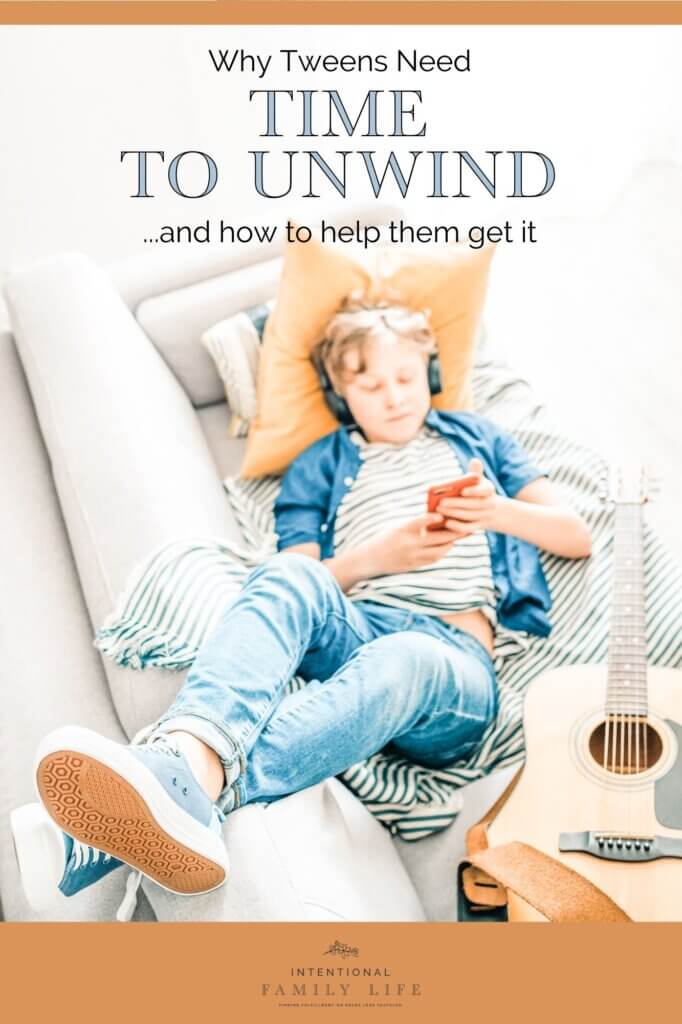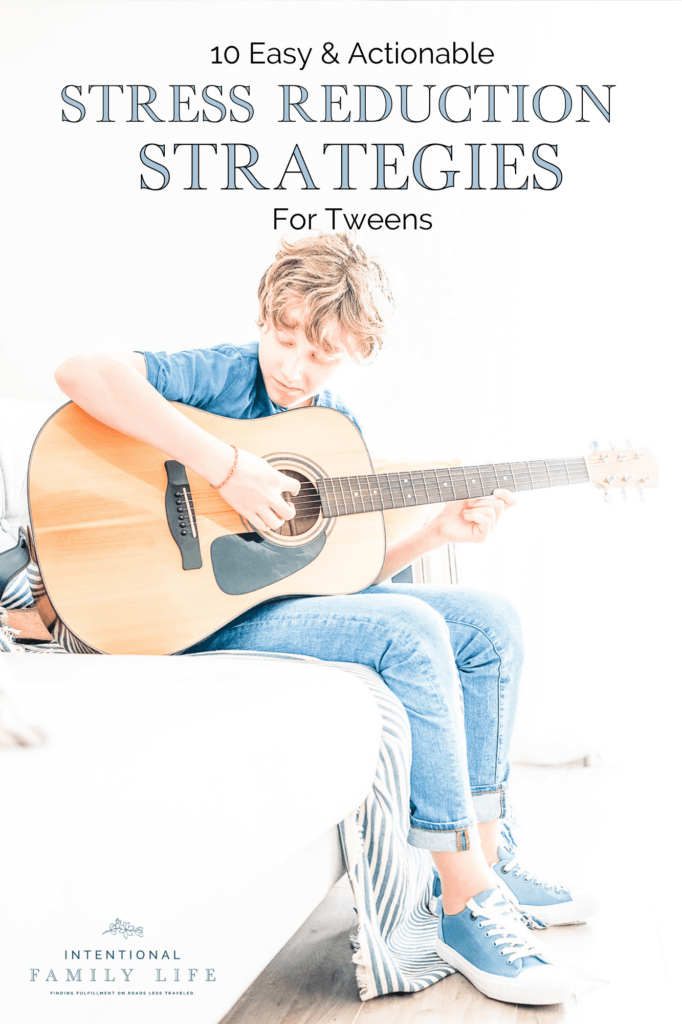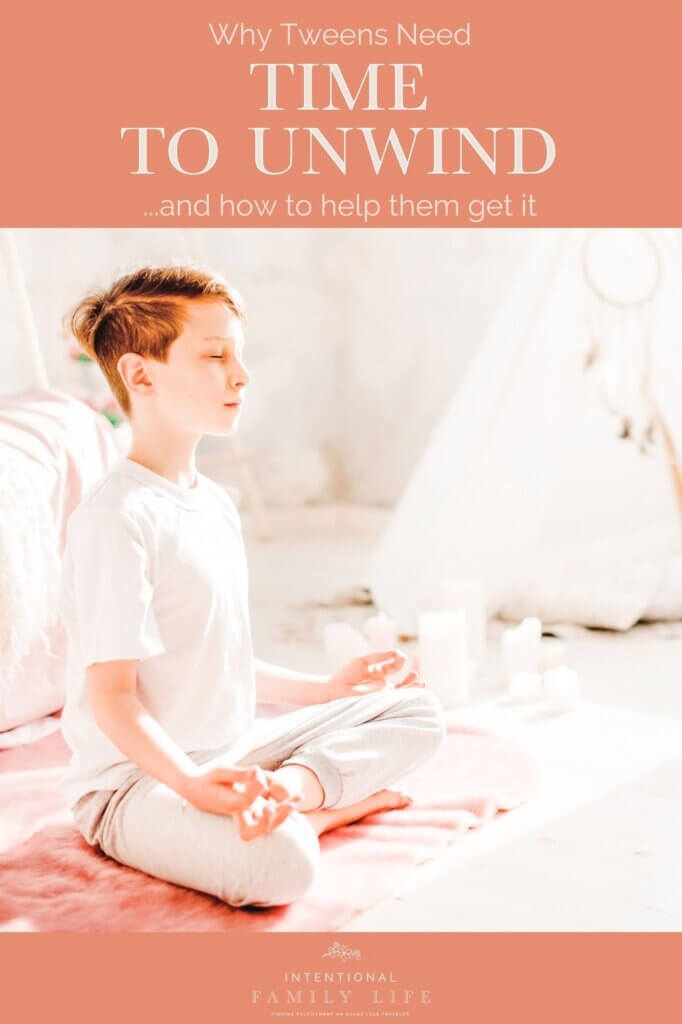Spoiler Alert: Our tweens are more stressed than ever and I’m sharing ten easy and effective stress reduction strategies. Reducing stress levels and negative thoughts can be tough for even the most practiced adults, and it’s even more difficult for inexperienced tweens. Chronic stress can lead to unhealthy negative thoughts, increased blood pressure, and other health problems. Stress reduction strategies such as exercise, getting enough sleep, mindfulness, or eating a healthy diet aren’t difficult. We just have to learn about them and teach our kids. Here, I’m sharing my top stress reduction strategies – no matter your age – but especially to help tweens. Often, pre-teens encounter more stressful situations than we ever know about. And here’s the best thing: I’ve both used these tips with my own family and I’ve confirmed with more than one practicing psychologist that they actually work!**

Finding Sources of Stress: The Early Years
Remember when your tween was little? Maybe even before they were talking with words that made sense?
I had what I called a “panic checklist.” When one of the boys would be wailing and my stress level went up – I had this “go to” mental check-list.
For me, the list started with a few deep breaths for mommy. Then it went like this:
Me: Clean diaper?
Also Me: *sniff* – check.
Me: Last time he ate?
Also me: Recently. He’s not hungry.
Me: Thirsty?
Me: Hmmm… Maybe? Want some water, baby?
Baby: *shoves water away*
Me: Gassy? *burps baby*
Me. Nada. (although I was never good at burping…so this would remain a “?” for me…)
Me: *checks watch* Nope. Not nap time, shouldn’t be tired.
Me: Wonder if he wants to go outside? Has he had a chance to run and play? That could be it!

Finding The Sources of Stress 2.0: The Tween Years
It’s not as easy to find the sources of stress as it used to be when you knew a sippy cup of water or a fresh diaper could fix just about anything.
Our tweens are notorious for not telling us everything. It’s important for them to feel that they are taking more and more control over parts of their lives.
But getting to the source of the stress is key to helping our kids understand that they can use stress reduction strategies to both reduce and manage stress. So what’s a mom to do?
I’ve got a solution. Download this lovely set of interactive situations to role play with your tween. Lots of potentially stressful everyday situations appear in these cards and I bet you’ll be surprised at some of what you learn your tween is grappling with every day!
Knowing what they struggle with is the first step in helping them implement stress reduction strategies and learn how to reduce overall stress and manage stress appropriately while in the thick of a situation.
What Causes Stress for Pre-Teens?
I’ve talked to so many parents who are surprised to discover that their tweens are feeling some serious stress and pressure in many or all aspects of their lives. And they have no idea about what stress reduction strategies are or how to implement them.
“We give him everything,” they say. What’s he got to be stressed about?”
You might just be surprised!
Tween boys and girls are definitely not known for their forthrightness in telling us when they feel stressed. And they definitely are not going to come home from school and say, “Hey, mom. Can you help me find some stress reduction strategies?”
For those of us not raised on the internet, it’s can even be hard to always know whether video games, social media, and the like actually function as sources of stress or stress reduction (it can be both for some kids or one or the other for different kids).

Top 10 Causes of Stress for Pre-Teens Today
- faster child development
- academic pressures and high stakes test taking
- over stuffed schedules
- fewer outlets for stress
- media saturation and viewing age inappropriate content
- bullying and teasing
- not enough sleep
- chronic illnesses
- disruptions within the family
- parental stress
Imagine For A Moment…
This is the best explanation of stress and our nervous system I’ve ever heard. And it’s a terrific explanation of precisely why stress reduction strategies work.
It came to me from a brilliant Occupational Therapist friend of mine who works with children with sensory differences.
She said, Imagine a glass. Let’s say this glass represents our capacity to navigate stressful and not so stressful challenges. Throughout our day, it takes on marbles for each “stressor” that we experience. The more stressful, the more marbles get added to the glass. Until the glass simply can’t hold any more.
So let’s pretend that your 11 year old daughter hasn’t been getting all the nutrients she needs for her brain and body to function well. You can add several marbles to her glass.
And let’s say she was up late last night studying and texting with her friends and didn’t get enough sleep. Add several more marbles to her glass.
She’s also been bogged down with projects for school, dance rehearsals, and basketball practice – so she hasn’t been outside much and might need some Vitamin D. Add marbles to her glass.
So, this morning she woke up with this imaginary glass two-thirds full of marbles and she hasn’t even brushed her teeth yet.
Now, she gets to school and her best friend is unexpectedly out sick. Add some marbles to her glass.
Substitute teacher? More marbles.
The fifth grade mean girl “accidentally” bumps into her and makes her drop her science project that she’s been working really hard on. If it’s not ruined, it’s certainly broken. Lower grade = More marbles.
Oh, and this happened in front of the smart guy that she’s crushing on just a bit. More marbles.
And her day goes on from there.
When you pick her up, you ask how her day was (silly mother).
And you may be able to guess her answer.
“Fine.”
Digging deeper, you ask, “What are you studying in social studies?” And…yep. That was it. That was the moment:
Wait. Whaaaaaaat?
What happened?
The marbles happened.
Stress reduction strategies weren’t in place.
Your question was the final marble that made the glass overflow. There was nothing wrong with your question.
And if her glass of marbles hadn’t just overflowed, she probably would have told you all about it.
You see, much of our stress is chronic or unrelated to things we are consciously aware of.
When our kids start the day with an empty glass of marbles, they have a greater capacity to navigate the stressful situations of the day.
So How Do I Know If My Tween Is Under Too Much Stress?
If you’re wondering if your tween is under stress, the answer is probably yes. Yes, your tween is likely struggling with some degree of stress.
Sign up and get this FREE role-playing game that gives you insight into your tweens carefully guarded world.
But how do you know if it’s too much? Here are some signs to look for:

Signs That Your Tween May Be Under Too Much Stress
- difficulty concentrating
- loss of motivation
- irritability or moodiness (that is out of character)
- unexplained changes in school performance
- withdrawing from friends
- withdrawing from activities that they previously enjoyed
- trouble sleeping
- tense muscles, headaches, a tight jaw, teeth-grinding, a racing heart, stomach aches, sweaty palms, or trips to the school nurse
- low energy, tiredness or exhaustion
- sleeping more or less than usual
- eating more or less than usual
- feelings of being overwhelmed.
How can we help our kids start the day with a glass either empty or nearly empty of marbles?
The First Five De-Stressing Go-To’s
I sort of feel guilty even including these here – because you already know them.
Just like the checklist you had for your baby (who’s now likely taller than you), you can have a tween checklist. It’s actually pretty similar…
I realize that as moms we learn all these things about our babies. Yet, when our kids grow up, we just sort of think they don’t matter any more. Now, with hormones surging, school pressures, bullies, temptations, growing independence, a world on pandemic lockdown, there’s a lot for our kids to be stressed about.
Adolescence is a crucial period for developing social and emotional habits important for mental well-being. These include adopting healthy sleep patterns; exercising regularly; developing coping, problem-solving, and interpersonal skills; and learning to manage emotions. Protective and supportive environments in the family, at school and in the wider community are important.
WHO – Adolescent Mental Health
So these first five are similar to the checklist you may have had for baby. They are things that impact the physical body and can add to stress levels if they aren’t optimized.
Now before you go bonkers with worry – none of us is perfect. And I’m not saying you have to be.
We order take out pizza. Five nights in a row. We watch a family movie, have friends over, or stay out too late. But the closer you can get to optimizing these first five, the better off you’ll be.
It’s not all or nothing here. It’s baby steps.
The First Five…
01
Eat nutrient dense foods.
02
Get enough sleep.
03
Stay active.
05
Avoid chemical and other toxins.
Get My Tween Conversation Tips
Name Stress and Normalize It
Sometimes I feel like “normalize” should be my middle name. I think there is great power in taking something frightening or taboo – like stress – and normalizing it. Explaining that not all stress is bad. (I also get freaked out that we are taught to normalize that which isn’t normal…)
Stress is one of our bodies communication signals. At its best, stress or nervousness before a performance or before the big game actually helps us prepare and perform at our best. A normal level of stress is a great motivator to study for the test or practice for your flute recital one more time.
I’ve heard Glennon Doyle refer to this feeling as “skited.” It’s her family’s mashup of scared and excited and I think it perfectly describes this good kind of stress. This is stress that motivates us to work hard and ultimately achieve.
But when that level of stress becomes chronic, unbearable, or interferes with daily activities (and might even make your tween seem lazy…), it can be bad for both physical and mental health. (stress and stress management in pre-teens and teenagers)
This is when it helps to name it. It really doesn’t matter what you name it – worry, stress, Fred, or Sandra – it can be anything. But then you can talk about it in an assertive and age appropriate way.

Spend Family Time
Connection. Connection with my family is what I am all about. Having supportive family members as touch stones for when we have stressful days can be so helpful.
Spending time together as a family will provide laughter (proven to reduce stress!), an emotionally safe space, and strengthen connections. Plan for some quality family time each day – dinner; an after dinner walk or game; breakfast if dinner doesn’t work for you; or ocasionally just a movie if everyone is exhausted.
And, I’m going to say something that may surprise you. I’d tell you what podcast I heard this on – but I forget stuff. So, no can do at the moment.
WARNING: I’m going to ruffle some feathers here. Mine is not the popular opinion.
Quantity of time can be just as important as quality.
Let me say this again – quantity of time matters. And here’s why:
So many times, those unplanned juicy conversations crop up when we’re just together for no particular reason.
Or the next hysterical “inside” family joke crops up. Just because we were together and it had the chance.
Or 5 minutes of laughter that makes somebody spew liquid out of their nose or snort (ok, that’s not usually a random somebody, that’s me) comes along.
These tiny moments, collective experiences, and memories are what create the quilt of our lives. (I know that sounded corny, but still…it sounds better in my mind and in Susan Sarandon’s voice. Go figure.)
Spend One on One Time
Just as important is one on one time with each of your kids. I know – this sounds really tough to achieve. But – it’s important. Grab a cheat sheet below to help you sail through one on one time!
Ways to Be Present Every Day With Your Kids
Grab the Cheat Sheet!
Does spending one on one time with each of your kids feel overwhelming?
Let me help make it feel easy and simple with tons of easily actionable – do it now – ideas for quality time.
Communication is also key. Especially at this age, you’ve likely noticed that your kids prefer one parent or the other to share specific issues with. So having those opportunities for discussion available is important.
Savvy parent tip: meaty conversations frequently involve situations where no eye contact is involved. Think: driving the car, “watching” tv, playing cards (we play double solitaire) or anything that allows you to have conversation while your eyes are elsewhere.
Communication helps you hear and understand what’s going on in their lives. You don’t have to solve their problems – but listen, listen, listen. Let them know that you really hear them!
Understanding our tweens isn’t always easy, but feeling heard is so important – it’s akin to feeling loved.
And feel free to admit when you genuinely don’t understand their situation. Another great stress reduction strategy is to make sure our kids feel safe to bring even the most awkward conversations to us.
And depending on their age, you can prompt them to construct potential solutions and to think through the possible consequences of each one.
Or, if they are older and its appropriate, you can just reassure them that you have confidence in their ability to make a good decision (I know you might not really have confidence – but those are the right words to say. When it all falls apart, you can be there for them later).

Stress Reduction Activities for Tweens Can Be Learned & Practiced On The Regular
Remember, stress reduction strategies can happen every day and every way – it’s a lifestyle. This is the marathon, not the sprint. Click below to see a great list of books and activities – separated by age – to share with kids for even more stress reduction strategies.
Want a great book and activity list, by age, of stress reduction strategies?
Click below to see our book list!
Get out! No. I mean, literally. Get out! Get outside.
Modern life is radically different from our days as cavemen, but our brains are mostly the same. Humans connect deeply with nature, and research proves that we suffer emotionally when we don’t nurture that bond. Check out one of our favorite family outdoor activities!
Time outdoors in nature helps relieve stress and anxiety and it can improve your mood and boost your feelings of happiness!
“Whatever you call it – forest bathing, ecotherapy, mindfulness in nature, green time or the wilderness cure — humans evolved in the great outdoors, and your brain benefits from a journey back to nature.” (Spend Time In Nature To Reduce Stress & Anxiety)
One of my favorite stress reduction strategies doesn’t really require an heavy lifting or deep “work” on my part. Creativity!!! Use your creativity to create something – and you’ll be surprised at what an emotional release it can be! Journal, knit, paint, draw, cook, rearrange your room – you name it. Get those creativity juices flowing. And if you’re thinking you’re not creative:
10 Creative Things You Can Do In 10 Minutes or Less
Grab The Creativity List!
Sometimes you just need a little kick in the pants to get started! This won’t hurt – and it’s 10 minutes or less.
So grab this cheat sheet of super easy ideas to dip teeeeeeenie tiny creativity toe in the water.
Mindfulness Based Stress Reduction Strategies & Relaxation Techniques
Kira Willey has this wonderful idea about “bite-sized mindfulness” for kids. Willey maintains that for mindfulness to be effective for kids, it needs to be short (as little as one minute is effective); engaging for kids; and consistent.
Mindfulness is a great skill for kids to learn. It helps them face daily challenges. The idea is that when they pay attention to breathing out and breathing in, they start to feel calm inside. Then they can learn to notice their feelings, even upsetting ones. This gives them time to decide what they want to do about the upsetting feeling, rather than reacting immediately. For example, mindfulness can help them feel less anxious. It can stop them from having a tantrum if they are frustrated or angry.
Meditation Practice Can Help Kids Become Less Anxious
Belly breathing is frequently included as a mindfulness technique. And I practice it myself – but until writing this post, I wasn’t aware of all of it’s benefits or why exactly it works!
“Chest breathing” makes the body tense, as if it’s under stress. Conversely, belly breathing is the most efficient and relaxing way to get air into your lungs. Belly breathing simulates breathing during our restorative times – think sleep, digestion, and resting. And belly breathing automatically slows our heart rate!
Stress Reduction Strategies to Challenge Negative Thoughts
Challenging negative thoughts is a daily struggle for me. I struggle to come up with the positive version of what I want to say, instead of the negative version which is what races to leave my mouth first.
I come by it honestly – I was raised by a pessimistic mother. And mom almost always saw the glass as half empty and would project all the atrocities to come from said half empty glass.
I’ve found that I adore the Big Life Journal products to help fill us with positive thoughts that are empowering.
My Favorite Tools For Transforming Negative Thoughts



When Stress Reduction Strategies Don’t Work
I want to add one note of caution for all you mamas out there. For all of us, stress reduction techniques can only take us so far.
If you are using one or more of these techniques and your child’s level of stress isn’t decreasing or her ability to be able to handle her current level of stress isn’t improving, I strongly encourage you to seek professional help.
PLEASE PIN THIS POST SO THAT YOU CAN COME BACK LATER!

**Please note: I am a mom. I am not a doctor, psychologist, or psychiatrist. If your child is experiencing anxiety beyond what can be reduced with typical stress reduction techniques, please seek the advice of your child’s doctor.











